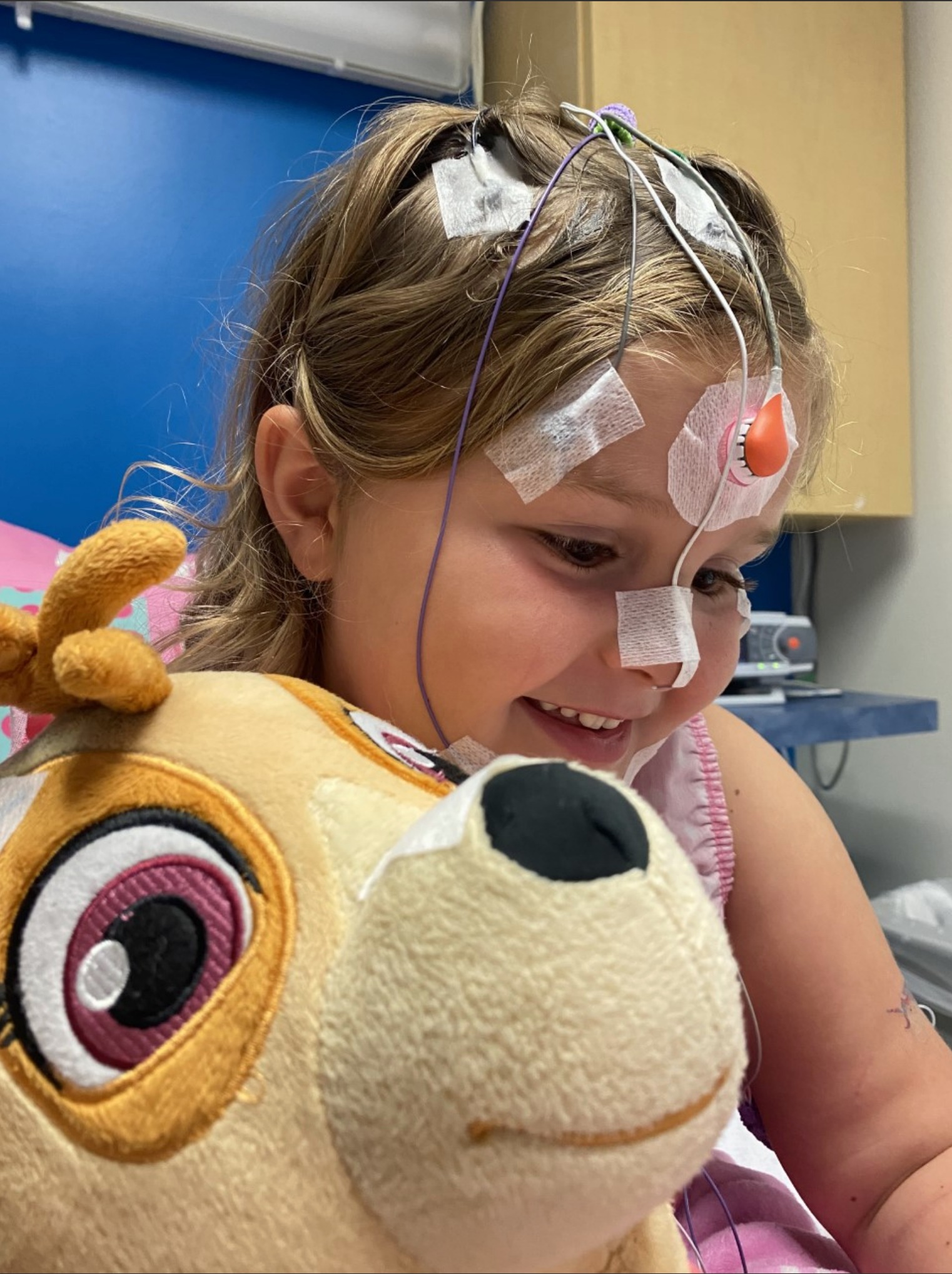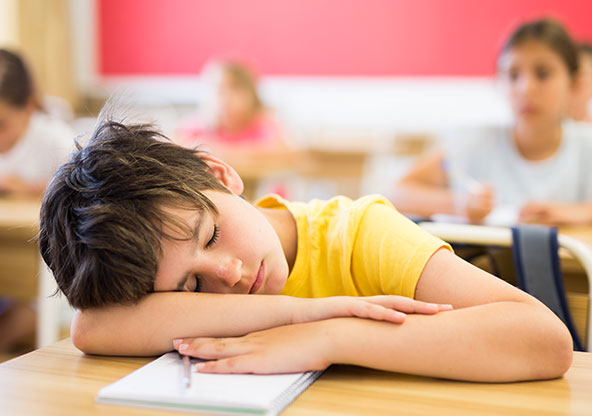Pediatric Sleep Apnea
Sleep problems are one of the most common concerns for parents. In fact, sleep problems have been estimated to affect 25 percent of children. Sleep is important for physical, mental, and emotional growth in children. Both the quality and the quantity of your child’s sleep are important.
We provide pediatric sleep studies for children as early as newborns. Our experienced, registered technologists provide a friendly and safe environment for your child’s sleep needs. A board-certified sleep medicine physician is available and specializes in all aspects of care of the sleep disorder patient.
What is Sleep Apnea?
Sleep apnea is a disorder that can affect people of all ages, including children and teenagers. It causes interruptions in breathing during sleep, resulting in poor sleep quality and daytime fatigue.
Knowing the signs of sleep apnea is important so your child can excel educationally and socially.
With early detection and treatment, sleep apnea can be effectively managed.
What Types of Sleep Apnea Do Children or Teenagers Experience?
Children and teens can experience Obstructive Sleep Apnea and Central Sleep Apnea.
Obstructive Sleep Apnea is the most common type of sleep apnea in children and teenagers. It occurs when the airway becomes blocked due to enlarged adenoids or tonsils.
Central Sleep Apnea is caused by a problem in the brain’s ability to control breathing and is much less common in this age group.
Both types of sleep apnea can cause a wide range of health problems. This can include cognitive and behavioral problems, poor growth and development, and high blood pressure.
What a Sleep Study Can Do For Your Child

Kynadee, who started Kindergarten in 2022, had prolonged signs of daytime sleepiness and moodiness.
After being referred by their healthcare provider, Michelle took Kynadee for a sleep study. While she slept, Kynadee was monitored for changes in oxygen and the number of apneic episodes she had during her sleep.
The results came back, and Kynadee was officially diagnosed with sleep apnea due to the size of her tonsils and adenoids. She was referred to Dr. Taylor Fordham Jr., an Otolaryngology Specialist at CHRISTUS Children’s in San Antonio.
She had her tonsils removed which helped her airway stay open while she slept.
After her surgery, Kynadee’s breathing and sleep improved dramatically. Her voice even changed because she was not straining to keep her airway open.
Kynadee finished Kindergarten with significant improvement in activities like retaining memory of her sight words, which helped her ability to read.
Why is Sleep Important for Kids?
During sleep, hormones are released that help with cell and tissue repair. This aids in the body’s growth process and helps with regular eating and maintaining a healthy weight. Sleep can help boost immunity and reduce the risk of developing certain diseases.
Sleep is essential to maintain physical and mental health. Lack of sleep can result in the following:
- Trouble focusing during school
- Issues with information processing
- Falling asleep during class
- Mood swings
- Poor academic performance
- Poor relationships with peers and family members
What are the Signs and Symptoms of Sleep Apnea?
Signs and symptoms of sleep apnea can include:
- Loud snoring
- Obstructive breathing episodes during sleep
- Abrupt awakenings during the night
- Morning headaches or difficulty waking up
- Excessive daytime sleepiness, fatigue, or unexplained anger
- Difficulty concentrating or paying attention to tasks for extended periods
- Unexplained weight change
- Behavioral problems, such as being wild and aggressive
In some cases, the child may have pauses in breathing during sleep that can last 10 seconds or longer. These pauses are known as apneic events and can be detected by a doctor using an overnight sleep study. Seek medical advice if your child or teenager has any of the above symptoms.
What Causes Sleep Apnea?
Obstruction of the airways while sleeping causes sleep apnea.
One common cause of sleep apnea in children or teens is enlarged tonsils or adenoids.
Other possible causes include obesity, allergies, and sinus problems that lead to swelling of the upper airway tissues.
In some cases, a deviated septum, which is an abnormal curvature of the nasal septum, can lead to sleep apnea.
What are Some Ways to Prevent and Treat Sleep Apnea?
Treating sleep apnea can include the following:
- Weight loss: Studies have shown that reducing body fat helps reduce the severity of sleep apnea symptoms. Excess weight can pressure your throat and cause it to collapse during sleep. This blocks the airway, causing apnea episodes. By losing weight, you may be able to open your airway and improve your breathing while you sleep.
- Avoid allergens: Dust, mold, pet dander, and pollen can cause constriction in the airway and lead to difficulty breathing while sleeping. By avoiding these triggers or reducing exposure to them, it may be possible to reduce the severity of sleep apnea symptoms.
- Nasal breathing: Nasal breathing can help prevent sleep apnea in children. Nasal breathing improves airway health and reduces the risk of blockage when asleep. Using a nasal strip or ensuring the child’s nostrils are properly hydrated with saline solution can help improve breathing.
- Positional therapy: Positional therapy can be a helpful tool in reducing sleep apnea symptoms in children and teenagers. Positional therapy encourages patients to sleep on their sides. Positional Therapy helps reduce snoring and improve breathing patterns during sleep.
What is the Difference Between Insomnia and Sleep Apnea?
Insomnia and sleep apnea are two distinct sleep disorders that can affect children. Insomnia is when you have difficulty falling, staying, or both. This can lead to impaired daytime functioning.
Sleep apnea occurs when breathing pauses occur during sleep due to airway obstruction. This can lead to interrupted breathing patterns and decreased oxygen levels during sleep.
With sleep apnea, however, this obstruction leads to breathing pauses throughout the night, disrupting normal sleeping patterns.
Stress, anxiety, or environmental factors cause insomnia. Sleep apnea is usually the result of physical issues related to the airways.
How Does a Doctor Diagnose Sleep Apnea in Children and Teenagers?
The diagnosis of sleep apnea in children begins with a physical exam and medical history. A child’s parent may fill out a questionnaire or do an interview. A doctor may also order various tests to help rule out other conditions and confirm sleep apnea.
These can include:
- An electroencephalogram to measure brain activity during sleep.
- An overnight sleep study (polysomnogram) to measure breathing patterns and oxygen levels
- A CT scan or MRI of the head to look for any underlying physical abnormalities.

